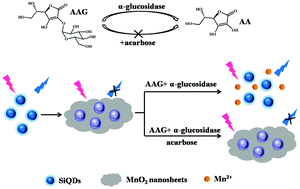A label-free fluorescent sensor based on silicon quantum dots–MnO2 nanosheets for the detection of α-glucosidase and its inhibitor†
Abstract
α-Glucosidase and its inhibitors play a key role in diagnosis and treatment of diabetes. In the present work, we established a facile, sensitive and selective fluorescence method based on silicon quantum dots (SiQDs) and MnO2 nanosheets for the determination of α-glucosidase and one of its inhibitors acarbose. The fluorescence of SiQDs was greatly quenched by MnO2 nanosheets due to the inner filter effect. α-Glucosidase could easily catalyze the hydrolysis of L-ascorbic acid-2-O-α-D-glucopyranosyl (AAG) to produce ascorbic acid (AA), which could reduce MnO2 nanosheets to Mn2+, resulting in dramatic recovery of the fluorescence of SiQDs. The proposed sensing platform could provide a good linear relationship between the fluorescence intensity of SiQDs and the concentration of α-glucosidase in the range of 0.02–2.5 U mL−1 with a detection limit of 0.007 U mL−1. In addition, the sensing platform could be used for α-glucosidase inhibition. Acarbose was one of the most common and typical inhibitors, and this sensing platform can be utilized to detect acarbose in the range of 1–1000 μM. The developed fluorescence method was successfully validated for the determination of α-glucosidase in human serum samples.



 Please wait while we load your content...
Please wait while we load your content...